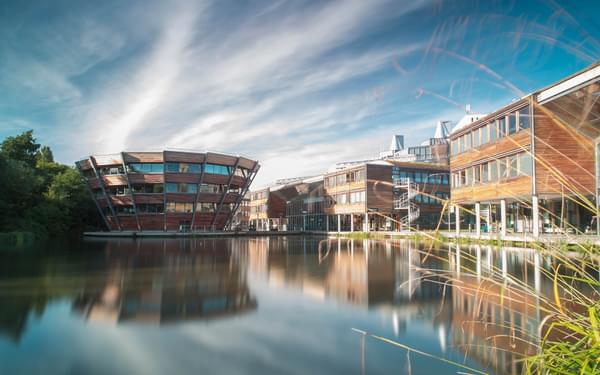
Attention is quite rightly focused on the NHS Green Plan and for NHS estates to meet a goal to be net zero by 2045 for emissions they can influence. But, with the temperature rising and an increased number of extreme weather events, adapting the NHS estate for the undisputed impacts of climate change is of equal importance.
The hot facts
Analysis by the FT, published in summer 2023, reveals that a third of hospitals, nursing homes and care homes in England are in areas that climate scientists predict will be at high risk from hotter summers by the 2050s. Indeed, the figure rises to nearly three quarters in London [1].
This piece by the FT was based on data from the Care Quality Commission and the Climate Just research group. The Climate Change Committee (CCC) had already warned the government in 2023 that progress on preparing healthcare facilities for warmer temperatures is too slow.
The activist body, Round Our Way, also published a report in summer 2023 on the impact of climate-induced heatwaves on the NHS [2]. Their research reveals that overheating incidents had doubled across the estate - including hospital wards and surgeries - in a five-year period between 2016/17 and 2021/22. The result had been cancelled operations, loss of medicine and staff shortages.
Heat is of course not the only impact of a changing climate. Increased rainfall and its impact when drainage systems can't cope are also affecting the NHS estate, plus the impacts of many combined natural changes that result in issues such as subsidence. A report by ITV News in 2023 confirmed that in the last three years, 171 incidents were recorded at 27 NHS trusts in England relating to flooding, power cuts and structural issues, resulting in wards and vital services being closed and suspended [3].
Impacts and concerns
For an over-burdened, yet absolutely vital societal asset, the importance of adapting facilities to cope with climate change has far-reaching impacts:
- Patient care is obviously critical - being comfortable, and being able to access services.
- Working conditions for every member of the NHS team - if it's too hot, this issue will rapidly become another reason why people don't stay in the sector.
- Potential for impacts from airborne carriers as rain and heat combine to bring new insects into our environment which in turn feed off standing water resulting from dated and over-burdened infrastructure.
- Existing chiller units unable to cope with demand and impacting on how vital medical supplies are maintained.
The Health and Care Act 2022 specifically states that NHS England must consider how it is going to 'adapt to any current or predicted impacts of climate change', and that NHS organisations 'will have to think about and be compliant with the UK's Climate Change Act 2008' [4].
Equally, the requirement to ensure premises are properly maintained and suitable for the purpose for which they are used has long been a requirement as stated in the Health and Social Care Act 2008 (Regulated Activities) Regulations 2014 [5].
Climate adaptation planning - understanding risk exposure
For NHS Trust estate teams and their advisors, the demand on their time and budget can feel over-whelming.
Heat decarbonisation, PFI hand-back, NHS Green Plan, compliance with the new Building Safey Act, and ongoing maintenance and rationalisation programmes dominate the agenda. And now, we're adding the need to adapt in the face of climate change.
However, a considered risk management approach can help to break down the task at hand. In fact, much of what is needed to adapt an estate will address day-to-day estate management, the decarbonisation agenda and ensure building safety.
Climate adaptation planning starts by understanding the likely exposure to risk. Our recommended approach is:
- Establish a climate risk assessment of the estate, taking account of the condition of every built and infrastructure asset - current and future climate data analysis from established sources will provide the key insights on likely climate trends for a specific geographical area.
- Create a risk register highlighting the short, medium and long-term risks for each asset.
- Detailed analysis of each asset to understand physical risk thresholds against climate change, the likeliness of this occurring and the consequence of these risks.
- Data can be nuanced to understand and prioritise action based on exposure to chronic (slow onset) and acute (extreme) climate hazards.
- Develop a robust heatwave plan to respond to increased periods of higher temperature.
- Identify and model adaptive measures based on interpreting the results of the climate risk study - measures can include passive and nature-based solutions, and more intrusive design interventions.
Preparedness is good capex planning
Climate change can be mitigated, but is now beyond reversion. However, if we take the 'crisis' out of what is undeniably a very serious problem, there are practical steps that NHS estates teams can take within their existing opex and capex budgets to respond to the findings of a climate risk study.
There's a range of very achievable engineering solutions that can be applied to prepare an estate, including:
- Opening up courtyards to provide natural and hybrid ventilation routes and access to daylight.
- Combining mechanical ventilation and sustainable solutions to keep an ambient temperature, recognising that in some areas where air needs to be changed regularly and medical supplies need to be protected, existing plant is either unable to cope anymore, or natural solutions are too risky.
- Introducing sustainable infrastructure with combined and simultaneous heating and cooling heat pumps to form a heating and cooling network.
- Work out where areas need full air conditioning with filtration, and where other areas can work with natural ventilation where practical.
- Review the location of chilled water plant for optimum operation.
- Adopt Passivhaus design principles and look at fabric first solutions.
- Invest in solar shading.
- Scope and invest in the realm around an estate to create green and blue infrastructure that introduces features such as sustainable drainage solutions through natural attenuation ponds to improve the ability to cope with excessive rainwater.
The NHS estate will make great strides in the coming years to decarbonise and meet its Green Plan, but in the face of climate change, this is only ever half of the exam question. How this vast estate adapts for the rapidly growing impacts of irreversible climate change is the other equally important challenge to tackle.
By understanding the risks, creating a robust risk register, and costing and modelling phased adaptation work, the NHS can shift and transform its vast and extraordinarily important facilities to a secure, resilient long-term future.
References:
[1] https://www.ft.com/content/47732c1e-1be7-4b71-9496-ade154cfb707
[2] https://www.roundourway.org/our-impact/nhs-overheating
[3] https://www.itv.com/news/2023-07-11/almost-50-of-hospitals-have-closed-wards-over-maintenance-issues
[4] https://www.bmj.com/content/378/bmj.o1681
[5] https://www.legislation.gov.uk/uksi/2014/2936/regulation/15/made














